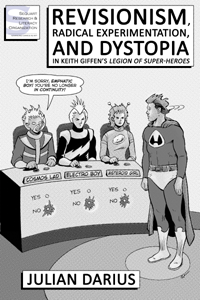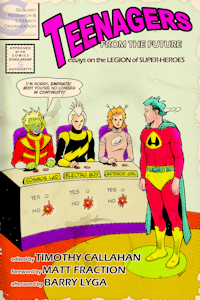Legion of Super-Heroes #31 (July 1992), co-written by Giffen and Tom & Mary Bierbaum, would go down in history as one of the most controversial Legion stories of all time. Taking a break from the war for Earth, the story focused on the long-standing relationship between Jan Arrah, formerly known as Element Lad, and the Legion’s former Science Police liaison, Shvaughn Erin.
The cover immediately announced that this issue was different. Illustrated by Colleen Doran, known for her art’s curved, mildly cutesy look, the cover stood out immediately, with stylistic continuity provided only by Al Gordon’s inks over Doran’s pencils. Far more striking was the apparent recasting of the series as a romance title. “Young” appears above the logo and “Romance” after it, so that the title appears to be Young Legion of Super-Heroes Romance. The Legion logo appears in pink. Shvaughn Erin stands crying behind an apparently indifferent Jan Arrah. In a time when word balloons on covers had already come to seem quaint, Shvaughn is saying, “(choke) He spends so much time saving the world… when will he find time for me?” A caption in the bottom left further enhances this melodrama: “All my life, happiness eluded my grasp… and nothing I ever cared about lasted! Was this the way it had to be with Jan too? The Elements of Heartbreak!” (The “A” of “All my life” is heightened and allowed to extend outside of the caption box, while “The Elements of Heartbreak” appears in larger red lettering, clearly indicating the story’s title despite being within the quotation marks.) Even the issue’s credits appear within a red heart.
While such play with cover design would become popularized after the year 2000, with titles such as Planetary and Promethea, American comics at the time were supposed to be instantly recognizable – and certainly were not supposed to change their genre so radically! During the 1980s, their once-inviolable title logos were outright changing or getting altered (as part of the cover art) with increasing frequency, and this probably accounted for why the Legion logo remained in its normal shape, however pink. But singular issues were not supposed to look this different, and the effect was decidedly unsettling.
Comics readers immediately recognized these as the tropes of American romance comics. (In the U.S., romance comics had been popular in the late 1940s and early ’50s, before giving way, after the establishment of the Comics Code Authority, to tamer fare like Archie. Many U.S. readers had seen older, melodramatic romance covers reprinted in the few books and many fan publications about the medium.) But while increasingly older and more sophisticated comic-book readers had come to embrace many experiments in narrative and format, romance comics were something else entirely. Besides being unpopular, romance comics were for girls, and readers of super-hero comics were overwhelmingly male. Issue #31 was something most male readers would have felt embarrassed to bring up to the cash register – in part, out of fear that they would be thought gay. All of this could not have seemed more out of place for a futuristic super-hero comic book.
Opening the comic did nothing to dispel the jarring change of style. Covers were routinely illustrated by artists other than the interior artists, sometimes with little stylistic similarity, so the reader might at least hope for another normal Legion installment within. Yet Jason Pearson’s stylized artwork was nowhere to be found, replaced by the decidedly girly look of Colleen Doran’s pencils. Legendary Superman and Legion artist Curt Swan had returned to pencil four pages, but while his style nostalgically evoked the Legion’s past, its curved, open linework suddenly seemed somehow eerily feminine. Keith Giffen even took the issue off as breakdown artist, removing even that consistency.
All of this was not only deliberate but quite brilliant. It was also, arguably, the supreme case of Giffen’s Legion alienating the reader. But this was not the only correlation with what Giffen had already done with the title: inside lay another revelation about a beloved Legion character, one far more controversial than those in the past.
The story, not so tonally different from the rest of Giffen’s Legion as the artwork would suggest, revealed that Shvaughn Erin, Element Lad’s long-standing and sexy girlfriend, was, in fact, a man. His / her “real” name was Sean, and he / she had changed his / her sex using the futuristic sex-change drug ProFem. She / he had only done this to get closer to Element Lad, on whom Sean had felt a crush, by becoming what he / she thought Element Lad really wanted. In an unexpected consequence of the recent turmoil on Earth, ProFem was no longer available, and Shvaughn was reverting, against her / his will, to Sean. Sean now struggled with feelings that Jan had never really known him / her, but Jan didn’t struggle over whether his love for Sean / Shvaughn was homosexual or not. Instead, Jan embraced his love for Sean as a person, saying that “anything we ever shared physically… was in spite of the ProFem, not because of it.” While not without ambiguity, this seems to state that Jan was always gay, whether he knew it or not.
Like the other retcons of the Giffen era, this ostensibly does violence to Legion history while actually respecting it, in subtle and interesting ways. Legion fans had long suspected that Element Lad, introduced all the way back in Adventure Comics #307 (Apr 1963), was gay. In his few potentially romantic moments with girls, he seemed exceedingly awkward. The previously-discussed Adult Legion stories established that Jan had not married, raising suspicion. He also didn’t have any visible children, perhaps strange since he was the last survivor of his planet, Trom. (Trom’s populace had been exterminated by the space pirate Roxxas because they refused to use their element-transmuting powers for his material gain. How a planet full of people who could transmute elements at will was so easily eradicated was never successfully answered – and, in the Silver Age, didn’t need to be.) As early as February 1976, at a convention, fans got the chance to address DC staff directly about the question, but that staff reportedly refused to answer and pushed onward to the next question. Not long after, longtime Legion writer Jim Shooter outlined his take on the various Legionnaires and stated that Jan was indeed gay. Around this time, unofficial fan fiction began featuring Jan in gay sex scenes. It was writer Paul Levitz who introduced Shvaughn Erin as a love interest for Jan, though it was Shvaughn who did all the pursuing and their relationship didn’t seem especially sexual. Many saw Levitz as intending to write Jan as straight but awkward with girls (this latter trait having been necessitated by his past characterization). So, while the revelation that the curvaceous Shvaughn Erin was actually a man surprised, the idea that Jan Arrah had been gay all along and had fallen in love only despite his sexuality was perfectly in line with the history of the character.
The resulting story, while a clever retcon consistent with Legion history, was also potentially emotionally touching. Very few gay characters had appeared in mainstream comics, gay themes had been addressed occasionally on television, and this was before the success of the 1993 film Philadelphia and the mainstreaming of gay culture. Yet here was a story in a super-hero comic not only about a gay super-hero but where the main conflict was not with a costumed villain but between people about their identity, their relationship, and their own deeply-felt insecurities. To be sure, this wasn’t a fully mature story about sexual identity, as the flamboyantly melodramatic cover suggested, but it was certainly groundbreaking.
It’s worth returning, briefly, to the issue’s cover. Giffen’s Legion had long risked alienating fans in several respects, but it had never potentially disrupted their enjoyment of the series as much as that cover did. After all, readers could still pick up an issue of Giffen’s Legion without fear of being thought somehow feminine or outright gay. Under the guise of a clever play with genre, of turning the cover into that of a romance comic, Legion of Super-Heroes had forced its generally still-young male readers to confront issues of their own sexual identity even before they read the issue. (Compounding this, U.S. comics readers have long been seen as geeky, in opposition to beefy jocks, and were thus more likely to be teased for being gay. One can only imagine the horror of some teenage male, dedicated to owning every issue of Legion but teased for being gay, hiding this issue among his weekly picks.) While almost certainly not in the mind of the issue’s creators, it helps to think here how genre in French means both “genre” and “gender.” It was almost as if, with the soft, curvaceous artistic style of Colleen Doran, the title itself had undergone a sex change, that cover screaming not only “romance comic” but “feminine.”
For all its brilliance, however, this was the issue that most clearly illustrated that Giffen’s ostensible plans for the series had gone off the track. It is one thing, in an experimental avant-garde comic book, even one with a continuing narrative, to have an issue that feels suddenly female and is cleverly recast as a romance comic. It is altogether another thing to do this in a comic telling an extended super-hero story set in a dystopic future. While modernism established realism as the tone of anything above trash fiction, generic consistency goes back even further. While super-hero comics had long ignored both, mixing unrealistic scientific devices with ghouls and hard-boiled detectives, the deconstructionist movement had attempted to turn the super-hero comic decidedly towards the realm of high art. Watchmen is as much praised for its constrained consistency as its realism. Giffen’s Legion had begun as a deconstructionist monthly super-hero work, telling a long, complex, dystopic story that included strong revisionist aspects, highly tied to super-hero deconstructionism. It had already lost some of that feel, partly due to shifting writers and artists. But more than an exercise in deconstruction, Giffen’s Legion had always been experimental, embracing narrative complexity and even narrative rupture. This was the issue that demonstrated, finally and without debate, that the experimental side ultimately trumped the deconstructionist one – that Giffen’s initial deconstructionist push had ultimately been more of an experiment than the beginning of a full-fledged deconstructionist masterpiece.
Gay themes may have been perfectly at home with the increased maturity embraced by deconstructionist super-hero comics. The revelations about Jan Arrah and Shvaughn Erin were utterly in tune with revisionism. But there simply could be no place for such genre inconsistency in such a movement, striving to be taken seriously as high art. That cover, more than anything, was just too damned irreverent.
Implicitly, this meant that Giffen simply didn’t have all the answers – that he wasn’t in control of his narrative. His tenure had seen the title’s narrative become almost impossibly complex, from the unknowns of the five-year gap to the retcons that followed and the introduction of the SW6 Legion. Now, it seemed as if he had introduced complexity and ambiguity more for their own sake than for any pre-planned pay-off. For many, lured into thinking that Giffen had a more conventionally deconstructionist narrative in mind, Giffen had lost the confidence of his readers.
































































